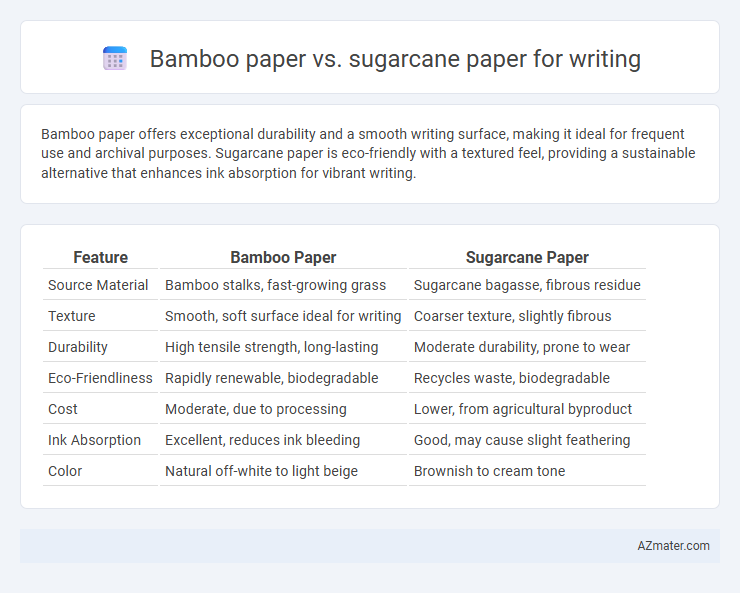Bamboo paper offers exceptional durability and a smooth writing surface, making it ideal for frequent use and archival purposes. Sugarcane paper is eco-friendly with a textured feel, providing a sustainable alternative that enhances ink absorption for vibrant writing.
Table of Comparison
| Feature | Bamboo Paper | Sugarcane Paper |
|---|---|---|
| Source Material | Bamboo stalks, fast-growing grass | Sugarcane bagasse, fibrous residue |
| Texture | Smooth, soft surface ideal for writing | Coarser texture, slightly fibrous |
| Durability | High tensile strength, long-lasting | Moderate durability, prone to wear |
| Eco-Friendliness | Rapidly renewable, biodegradable | Recycles waste, biodegradable |
| Cost | Moderate, due to processing | Lower, from agricultural byproduct |
| Ink Absorption | Excellent, reduces ink bleeding | Good, may cause slight feathering |
| Color | Natural off-white to light beige | Brownish to cream tone |
Introduction to Sustainable Paper Alternatives
Bamboo paper and sugarcane paper are innovative sustainable alternatives to traditional wood pulp paper, offering eco-friendly benefits through rapid renewability and reduced environmental impact. Bamboo paper, derived from fast-growing bamboo stalks, provides high durability and natural antibacterial properties, making it ideal for writing and printing. Sugarcane paper utilizes bagasse, the fibrous residue from sugarcane processing, which promotes waste reduction and lowers deforestation rates while maintaining smooth texture and excellent ink absorption for writing purposes.
Overview of Bamboo Paper Production
Bamboo paper production involves harvesting fast-growing bamboo plants, which are processed into fibers through mechanical and chemical pulping methods to create a durable and eco-friendly writing surface. The fibers are beaten and formed into sheets that exhibit high strength and smooth texture, ideal for writing purposes. Compared to sugarcane paper, bamboo paper offers greater sustainability due to bamboo's rapid regeneration and lower water consumption during manufacturing.
Overview of Sugarcane Paper Production
Sugarcane paper production utilizes bagasse, the fibrous residue left after extracting juice from sugarcane stalks, making it an eco-friendly alternative to traditional wood pulp paper. The process involves cleaning, pulping, bleaching, and drying the bagasse fibers to produce smooth, durable writing paper with a low environmental footprint. Compared to bamboo paper, sugarcane paper benefits from using agricultural waste, reducing deforestation and promoting sustainable resource management in the paper industry.
Environmental Impact: Bamboo vs Sugarcane
Bamboo paper offers a highly sustainable option due to bamboo's rapid growth and minimal need for pesticides, resulting in lower carbon emissions and reduced deforestation compared to traditional wood pulp. Sugarcane paper utilizes bagasse, a byproduct of sugar extraction, effectively repurposing agricultural waste and minimizing landfill accumulation, making it an eco-friendly alternative with a smaller environmental footprint. Both materials contribute to reducing reliance on virgin wood, but bamboo's regenerative qualities and sugarcane's waste utilization present distinct advantages in lowering environmental impact for writing paper.
Writing Quality: Texture and Smoothness Comparison
Bamboo paper offers a smooth texture with a slightly fibrous feel, providing excellent ink absorption and minimal bleed-through, ideal for fountain pen users seeking crisp lines. Sugarcane paper features a denser, more uniform surface that enhances writing clarity and reduces feathering, making it suitable for various pen types and ink formulations. Both materials deliver high-quality writing experiences, but sugarcane paper tends to excel in smoothness while bamboo paper offers a sustainable tactile richness.
Durability and Longevity of Both Papers
Bamboo paper offers superior durability due to its strong, fibrous structure, making it resistant to tearing and wear over time, while sugarcane paper, though eco-friendly, tends to be less robust and more prone to degradation with frequent handling. The natural lignin content in sugarcane fibers can cause faster yellowing and brittleness, whereas bamboo paper maintains its integrity and appearance longer under similar conditions. For writing purposes requiring lasting documents, bamboo paper provides enhanced longevity and strength compared to sugarcane paper.
Cost Analysis: Affordability and Accessibility
Bamboo paper generally offers a more affordable option due to the rapid growth and high yield of bamboo plants, reducing raw material costs compared to sugarcane paper. Sugarcane paper, made from bagasse, a byproduct of sugar production, can be cost-effective in regions with abundant sugarcane agriculture but tends to have higher processing expenses. Accessibility varies by geographic location, with bamboo paper more readily available in Asia and sugarcane paper favored in sugar-producing countries, influencing overall affordability based on supply chain factors.
Printing and Ink Absorption Performance
Bamboo paper offers excellent ink absorption due to its natural fibers, resulting in crisp, vibrant prints with minimal smudging, making it ideal for high-quality printing needs. Sugarcane paper, derived from bagasse, features a smooth texture that supports consistent ink distribution but may occasionally cause slight ink spreading under heavy printing loads. Both papers are eco-friendly alternatives, yet bamboo paper typically outperforms sugarcane paper in maintaining sharp print details and fast drying times during writing and printing applications.
Popular Uses and Availability in Markets
Bamboo paper is widely used for eco-friendly notebooks, stationery, and printer paper due to its smooth texture and durability, available predominantly in specialty and organic markets. Sugarcane paper, made from bagasse, is popular for packaging, notepads, and disposable writing materials, often found in mainstream office supply stores and sustainable product retailers. Both papers emphasize sustainability, though bamboo paper tends to be favored for higher-quality writing applications, while sugarcane paper excels in mass-market accessibility and cost-effectiveness.
Conclusion: Which Paper is Best for Writing?
Bamboo paper offers superior durability and a smoother texture, making it ideal for high-quality writing and sketching projects. Sugarcane paper, while eco-friendly and cost-effective, tends to be less smooth and more prone to ink bleed, which may affect handwriting clarity. For writers prioritizing performance and a premium writing experience, bamboo paper is generally the best choice.

Infographic: Bamboo paper vs Sugarcane paper for Writing
 azmater.com
azmater.com